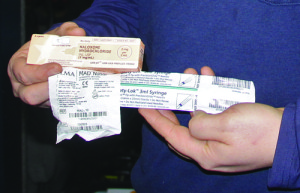Suffolk County reports surge in heroin-related deaths

Last week’s crackdown on a heroin ring brought to light a massive Harlem-to-Riverhead operation that used Route 58 as a distribution hub, but numbers provided this week by the Suffolk County Medical Examiner’s Office show that abuse of heroin is nothing new in our area.
According to data released by Dr. Michael Lehrer, chief toxicologist with the ME’s office, heroin-related deaths in Suffolk County have increased by almost 300 percent in the past four years — from 28 in 2010 to 64 in 2011 and 83 in 2012, with about 82 deaths (and counting) reported in 2013. Not all drug-related cases from 2013 have been officially concluded, according to county officials.
County Executive Steve Bellone called the growing popularity of heroin a “public health crisis” and both Southold Police Chief Martin Flatley and Riverhead Police Chief David Hegermiller reported that arrests related to the opiate drug have risen in recent years. State lawmakers are also reacting, proposing new legislation aimed at distributing Narcan — a treatment to prevent or reverse the effects of a heroin overdose — to people who are close to addicts and could use it to assist them in the event of an overdose.

The reality of the heroin epidemic hit close to home last Wednesday, when District Attorney Thomas Spota held a press conference announcing an East End Drug Task Force bust that broke up a ring connecting Riverhead with East Harlem. Nine men, including four from Riverhead and one from Calverton, were arrested for their alleged roles in marketing and distributing “premium” quality heroin, known by the street name “Hollywood,” in the parking lots of Route 58 businesses.
The “Hollywood” ring first caught the attention of the authorities two years ago, Mr. Spota said, adding that the locally distributed product was directly responsible for at least six overdoses across the East End because of its high potency.
“Obviously, people are becoming a lot more comfortable using heroin than they ever used to be and we definitely see that happening with more arrests,” Chief Flatley said.
In 2010, Riverhead Town didn’t report a single heroin-related drug overdose death. In 2011, however, that number jumped to six and, after a dip to four deaths in 2012, rose to seven in 2013, according to data Chief Hegermiller compiled from the county ME’s office.
The chief noted that in many cases, a mixture of different kinds of drugs was responsible for the overdoses — not heroin alone.
“It’s hard, in three short years, to tell what the story is, as the 2011 and 2013 numbers are very close,” he said, adding that no matter the numbers, “I am very concerned about it and I think we should all be concerned about it.”
Chief Hegermiller also said data from the last three years indicates that those who overdose on heroin are generally in their 40s, “putting a little bit of a different spin” on the common conception that heroin is more typically abused by younger people.
Riverhead Volunteer Ambulance Corps Chief Joseph Oliver said opioid antagonist medications like Narcan have allowed ambulance volunteers to save lives in Riverhead and have been used regularly. Corps volunteers, he said, treat about one heroin overdose patient every other month.
“Usually when we get there they’re not breathing, we start to get air into their lungs, get air into their brain. We give them the Narcan and within minutes, they wake up,” Mr. Oliver said.
It is not uncommon for volunteers to have to treat the same patient with Narcan more than once, he said.
“You get one person and you get them a couple times a week for like a month until either they get clean, they get arrested or they die,” he said.
“We just had one [patient] back in November. We helped him three times,” Mr. Oliver said. “They were all very close calls. He was dead and we brought him back.”
In 2013, the use of Narcan saved 563 lives countywide, according to Mr. Bellone’s office.
For the past several years volunteers administered the treatment both intravenously and by injecting it into muscles, including the heart. More recently, a nasal spray has become available, Mr. Oliver said. “It’s really easy to use.”
Currently, local ambulance volunteers carry opioid antagonists but area police do not. Chief Flatley and Chief Hegermiller, however, both said it is only a matter of time before the Suffolk County Police Department’s Narcan program, which started in June 2012, reaches local departments.
In January, state Senator Kemp Hannon (R-Nassau) and Assemblyman Jeffrey Dinowitz (D-Bronx) introduced matching legislation that, if passed, would allow physicians to prescribe opioid antagonists like Narcan to individuals who know someone at risk.
This way, they say, family members, friends or others in a position to help someone who might overdose on an opioid can be prepared to intervene with a life-saving treatment.
With Paul Squire


